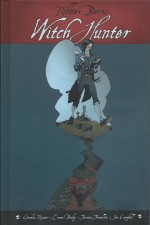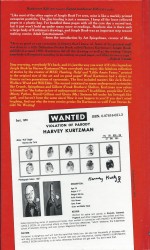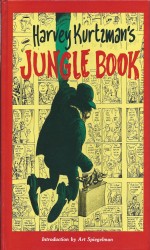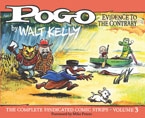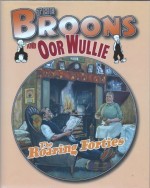
By Harvey Kurtzman (Kitchen Sink Books/Dark Horse Books)
ISBNs: 978-1-61655-563-4
Win’s Christmas Gift Recommendation: Buy It Now, Love It Forever… 10/10
Well this is embarrassing…
About a month ago, after literally years of waiting impatiently, I finally reviewed one of the earliest classics of our art form, impetuously deciding that at least some of you might find and delight in Harvey Kurtzman’s Jungle Book through second-hand and pre-owned suppliers.
Apparently, even as I was whining about the thing not being in print, superbly crafted copies of a wonderful new deluxe hardcover edition were winging their way around the planet thanks to the perspicacity of those fine people at Dark Horse and Kitchen Sink.
That will teach me to actually read some of the online reports and press releases we’re bombarded with here at Grumpy Old Luddite Central…
Still my humiliation is your good fortune as this magnificently oversized (297x184mm) masterpiece is ready to buy and just in time to make this Holiday Season a time of wickedly barbed merriment…
Here in Britain we think we invented modern satire, and quite frankly it’s a pretty understandable notion, with “The Great 1960s Satire Boom†producing the likes of Peter Cook, John Bird, John Fortune, Bernard Levin, Richard Ingrams, Alan Bennett, Paul Foot, Ned Sherrin, Jonathan Miller, David Frost and institutions such as The Establishment club, That Was the Week that Was and the utterly wonderful Private Eye (long may She reign, offend, fly at Gads and survive repeated libel and defamation writs – there’s a Christmas Annual out even as we speak…).
Sadly our American cousins were not so magnanimously blessed. Their share of genuine world-changing, liberal-lefty rib-tickling intellectual troublemakers only really comprised Tom Lehrer and Harvey Kurtzman. Of course it is a very large country of excitable citizens, with an unbelievable number of guns equally distributed amongst smart folks, idiots and outright lunatics…
Creative genius Harvey Kurtzman is probably the most important cartoonist of the last half of the last century – even more so than Jules Feiffer, Jack Kirby, Joe Kubert or Will Eisner.
His early triumphs in the fledgling field of comicbooks (Frontline Combat, Two-Fisted Tales and especially the groundbreaking, game-changing Mad) would be enough for most creators to lean back on but Kurtzman was also a force in newspaper strips (Flash Gordon Complete Daily Strips 1951-1953) and a restless innovator, commentator and social critic who kept on looking at folk and their doings and just couldn’t stop making art or sharing his conclusions…
He invented a whole new format when he converted the highly successful colour comicbook Mad into a black-&-white magazine, safely distancing the brilliant satirical publication from the fall-out caused by the 1950s comics witch-hunt which eventually killed all EC’s other titles.
He pursued comedy and social satire further with the magazines Trump, Humbug and Help!, all the while creating challenging and powerfully effective humour strips such as Little Annie Fanny (for Playboy), Nutz, Goodman Beaver, Betsy and her Buddies and many more. He died far too soon, far too young in 1993.
In 1959, having left Mad over issues of financial control and with both follow-up independent ventures Trump and Humbug cruelly defunct, the irrepressible Kurtzman convinced Ballantine Books to publish a mass-market paperback of all-new satirical material. That company had just lost the rights to publish Mad‘s phenomenally best-selling paperback reprint line and were cautiously amenable to a gamble…
The intriguing oddment saw the Great Observer in top form, returning to his comic roots by spoofing and lambasting strip characters, classic cinema, contemporary television and apparently unchanging social sentiments in a quartet of hyper-charged tales. Unfortunately the project was the first of its kind in America and met with far less than stellar success. No one had ever published 140 pages of new comics in one savage bite before, and even the plenitude of strip reprint books packing bookshop shelves and newsstand spinners were always designed with one eye on the kids’ market.
This new stuff was strictly for adults who would happily follow newspaper or magazine strips but didn’t want to be seen carrying a whole book of them. Duly enlightened, Kurtzman instead returned to safer ground and launched Help! just in time for the aforementioned Swinging Sixties’ satire boom…
The slim monochrome package might not have changed the nation but it certainly warped and affected a generation of budding cartoonists and writers. Quickly becoming a legend – and nearly a myth in many fan circles – Jungle Book was rescued from limbo in 1986 when cartoonist, publisher and comics advocate Denis Kitchen released the entire lost volume as a deluxe oversized collectors hardback edition through his Kitchen Sink Press.
Adjudged by The Comics Journal as #26 in the “Top 100 Comics of the 20th Centuryâ€, the racy, revelatory controversial – and in 1959 completely ignored – tome’s full title is Harvey Kurtzman’s Jungle Book: Or, Up from the Apes! (and Right Back Down) – In Which Are Described in Words and Pictures Businessmen, Private Eyes, Cowboys, and Other Heroes All Exhibiting the Progress of Man from the Darkness of the Cave into the Light of Civilization by Means of Television, Wide Screen Movies, the Stone Axe, and Other Useful Arts and this latest edition brilliantly gilds the graphic lily with a host of extra features and treats.
Augmented by a wealth of candid photos, covers and sketches from other works, this new chronicle of craziness offers an effusive Introduction by Gilbert Shelton and a fascinating and informative essay by Kitchen entitled ‘It’s a Jungle Out There!’ which reveals the tone of the times and discloses the background behind the novel novel’s creation.
Also included is the 1986 Kitchen Sink edition’s ‘Intro’ by rabidly devoted fan Art Spiegelman and, after the words and picture-fest concludes, a captivating ‘Epilogue’ ensues in the form of a scholarly ‘Conversation between Peter Poplaski and R. Crumb’…
The material itself is gloriously timeless and revelatory. In 1959 it gave the author an opportunity to experiment with layout, page design, narrative rhythms and especially the graphic potential of lettering, all whilst asking pertinent, probing questions about the world rapidly changing all around him.
Each tale in the quartet is prefaced by Kurtzman’s own commentary as shared with comics historian Dave Schriener for the 1986 Edition…
‘Thelonius Violence, Like Private Eye’ is ostensibly a parody of groundbreaking TV show Peter Gunn, with the jazz-loving, hipster “White Knight for Hire†scoring chicks and getting hit an awful lot as he infallibly and oh-so-coolly tracks a killer whilst protecting blackmail victim Lolita Nabokov…
The tale is slick and witty and sublimely smart, whereas the next piece (barely) contains a lot of pent-up frustration for past sins and misdemeanours.
In creating ‘Organization Man in the Grey Flannel Executive Suite’ Kurtzman accessed his experiences working for low-rent publishers and bosses (such as Marvel’s Martin Goodman) to create the salutary tale of a decent young man’s progress up the corporate ladder at Shlock Publications Inc.
The quasi-autobiographical, impressionable and ambitious naïf in question is Goodman Beaver (who would be resurrected for Help! and eventually, improbably evolve into Little Annie Fanny) and his transformation from sweet kid to cruel, corrupt, exploitative average business jerk makes for truly outrageous reading.
The title comes from a trio of contemporary bestsellers on the subject of men in business: Executive Suite by Cameron Hawley (1952), The Man in the Gray Flannel Suit by Sloan Wilson in 1955 and William H. Whyte’s 1956 drama The Organization Man.
‘Compulsion on the Range’ simultaneously spoofs top-rated western Gunsmoke and the era’s growing fascination with cod psychology and angst-ridden heroes as Marshal Matt Dolin‘s far-reaching obsession with out-shooting infallible outlaw Johnny Ringding which takes him to the ends of the Earth…
The cartooning wraps up with an edgily barbed tribute to Great Southern novels like Erskine Caldwell’s Tobacco Road and God’s Little Acre or assorted works of William Faulkner and Tennessee Williams, filtered through a glorious froth of absurd melodrama, frustrated passions and steamy sex (by all accounts the Very Best Kind), all outrageously delivered via astoundingly rendered caricatures and inspired dialect and accent gags.
The tale was inspired by the time Kurtzman spent in Paris, Texas during his wartime service…
In ‘Decadence Degenerated’ us’n sees thet nothin’ evah changes in sleepy ole Rottenville. Then wun naht, when the boys is jus’ a-oglin’ purty Honey-Lou as ushul, sommin’ goes awry an’ it all leads to murdah an’ lynchin’ befoah some snoopy repohtah who claims he frum up Noath turns up thinkin’ he can fin’ the truth…
Soon vi’lint passions is furtha aroused and nuthin’ kin evah be the same agin…
Funny, evocative and still unparalleled in its depth, ambition and visual potency, Harvey Kurtzman’s Jungle Book inspired and influenced creators and storytellers as disparate as Robert Crumb, Art Spiegelman, Gilbert Shelton and Terry Gilliam. This is a masterpiece of our art form which no true devotee can afford to be without.
Harvey Kurtzman’s Jungle Book (Essential Kurtzman Volume One) © 2014 Kitchen, Lind & Associates, LLC. All contents © and/or â„¢ their respective creators or rights holders. All artwork and stories © the estate of Harvey Kurtzman unless noted.  All rights reserved.

